|
|
|
About us
Alhambra Granada
Hotels
Maps
Nerja
Nerja caves
Frigliana |
|
|
Granada lies high in the mountains, within sight of the snow covered peaks of the Sierra Nevada (which, in fact, means "snow covered peaks)Inhabited by people since prehistoric times, the area was originally known as Ilbyr. The Romans built a city here called Illibris, followed by the Arabs, who, in the 8th century, named this glorious city Granada and built the Alhambra Palace. The Arabs occupied this area of Spain for over 700 years. and Granada was the last Muslim city to fall to the Christians in 1492, led by Queen Isabel of Castile and her husband Ferdinand of Aragon. All of the Muslim Holy places were destroyed and replaced with Catholic Cathedrals and Churches, mostly built on the same site as the old Mosques. |
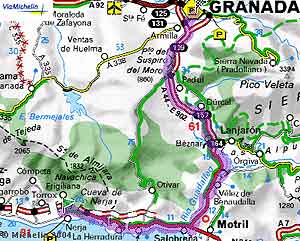 |
|
Granada was the
capital of the Muslim Nasrid Kingdom, and they poured a great deal
of their wealth into beautiful architecture, and this is reflected
in the palaces of the Alhambra, where the best craftsmen in all of
Spain came together in the 200 years of construction between the
13th and 15th centuries. |
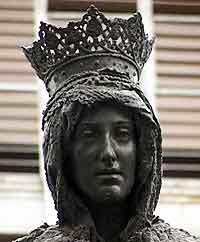 |
The Catholic Queen of Castile, Isabel, was born on Thursday,
April 22 1451, the same year that Mahmet II, the terror of
Europe, became Sultan of Turkey. She was the
daughter of King Don Juan II of Castile and the Queen consort
Isabel of Portugal, his second wife. The Infanta was the second
in line of the royal succession after her half brother Enrique,
the son of King Juan II and his first wife Queen Maria of Aragón. |
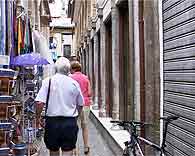 |
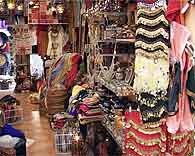 |
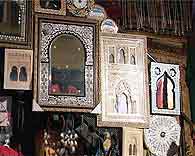 |
|
The Moorish influence on Granada can still be seen in the numerous narrow streets selling all kinds of Eastern produce, from wood crafts, to belly dancing outfits. |
| Her leadership itinerary in the year
of 1492 included: January, the introduction of the Spanish Inquisition and the conquest of the Kingdom of Granada March, the conversion and expulsion of the Jews April, she sent Christopher Columbus to discover the new world! Isabel was convinced by Christopher Columbus to sponsor his voyage of discovery. The lasting effects of this were many: by the traditions of the time, when Columbus discovered lands in the New World, they were given to Castile. Isabella took a special interest in the Native Americans of the new lands; when some were brought back to Spain as slaves she insisted they be returned and freed, and her will expressed her wish that the "Indians" be treated with justice and fairness. |
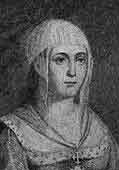 |
|
Princess Isabel was three years old when she heard of the fall
of Constantinople, the capital of the Eastern Roman Empire
founded by Constantine, a Roman Emperor, a millennium earlier.
She was taught everything from the classics, including the
secret of secrets which the philosopher Aristotle made to
Alexander the Great: "To value practical wisdom above virtue and
to give the appearance of virtue". This principle Queen Isabel
was to apply well during the re-conquest of Spain from the
Moors. |
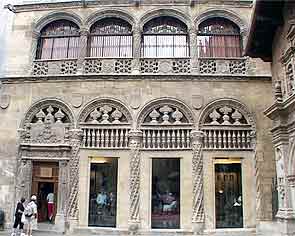 |
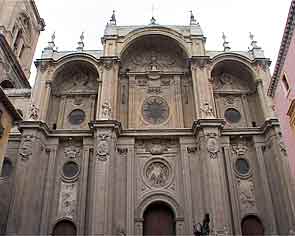 |
|
|
Queen Isabel died on Tuesday, November 26, 1504, at the age of 53. She was interred in a small coffin, which can be seen next to her husband Ferdinando's coffin in the crypt of the sacristy of the Royal Chapel close to the Gothic Cathedral of Granada (see next picture) |
Construction began in
1518 in the centre of the old Muslim Medina, the work lasted two
centuries. |
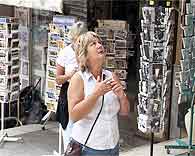 |
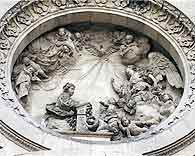 |
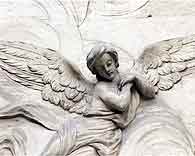 |
|
The Gothic Cathedral towers over the Plaza de las Pasiegas, and Carol has to crane her neck to view the wonderful statues and reliefs on the Cathedral walls |
||
|
The kingdoms of Castile and Aragó n had been fighting a civil
war for 20 years from 1460 to 1480, and Isabel understood that
her kingdom did not stand a chance against her powerful
neighbours of France, Navarre, Portugal and Granada, the Moorish
Kingdom of the South. During the war of the Roses in England,
the Catholic kings allied with the Red Rose and the Tudors. When Isabel married at the tender age of 19 years old, on October 19, 1469, she founded Spain. She was named "Catholic Monarch" by Pope Alexander VI, and was the dominant ruler of the union. Castile, her kingdom, was three times as large as Aragón and was centrally located. The Catholic Monarchs were not gods but claimed that their power to rule came directly from God. The Castilian language also became predominant over Galician, Basque, Navarrese and Catalan. Castilian became an instrument of the Spanish Empire, just as Latin became an instrument of the empire of Rome. Isabella was the first named woman to appear on a United States coin, an 1893 commemorative quarter, celebrating the 400th anniversary of Columbus' first voyage. |
| There had been settlements in
Granada, or Ilbyr as it was then known for many centuries before
the Romans came, named the area Illibris and built a
fortress on Albaicin Hill, where the old Moorish casbah is now
found. When the Moors arrived in the 8th century, they occupied
the area along with the rest of southern Spain. But it was only
after the fall of Cordoba to the Christians in 1256 that Granada
became an important city. The centre of Moorish power was
transferred to Granada, bringing a massive influx of nobles,
architects and money which eventually led to the construction of
the Alhambra. Granada was the only surviving bastion of Islam in
Spain until finally the last Arab king had to relinquish the
city to Ferdinand and Isabella in 1492. During those intervening
two and a half centuries, the city reached a cultural zenith.
The Spanish further enriched Granada with splendid Renaissance
and baroque buildings for nearly another century before the
city's importance began to decline. Both Ferdinand and Isabella chose to be buried here because they considered the conquest of Granada their crowning achievement. Granada a beautiful, romantic, individual and distinctive city is an important university town, a quarter of its inhabitants studying or teaching at the illustrious and very old university. Carlos I of Spain and V of Germany founded the university, it was inherited from the old Islamic University founded by Sultan Yusef I several centuries before. |
|
About us
Alhambra Granada
Hotels
Maps
Nerja
Nerja caves
Frigliana |
|
View some of our other holiday destination
videos |
|
Visit one of our other
Holiday destinations |
|
This website designed &
hosted by |